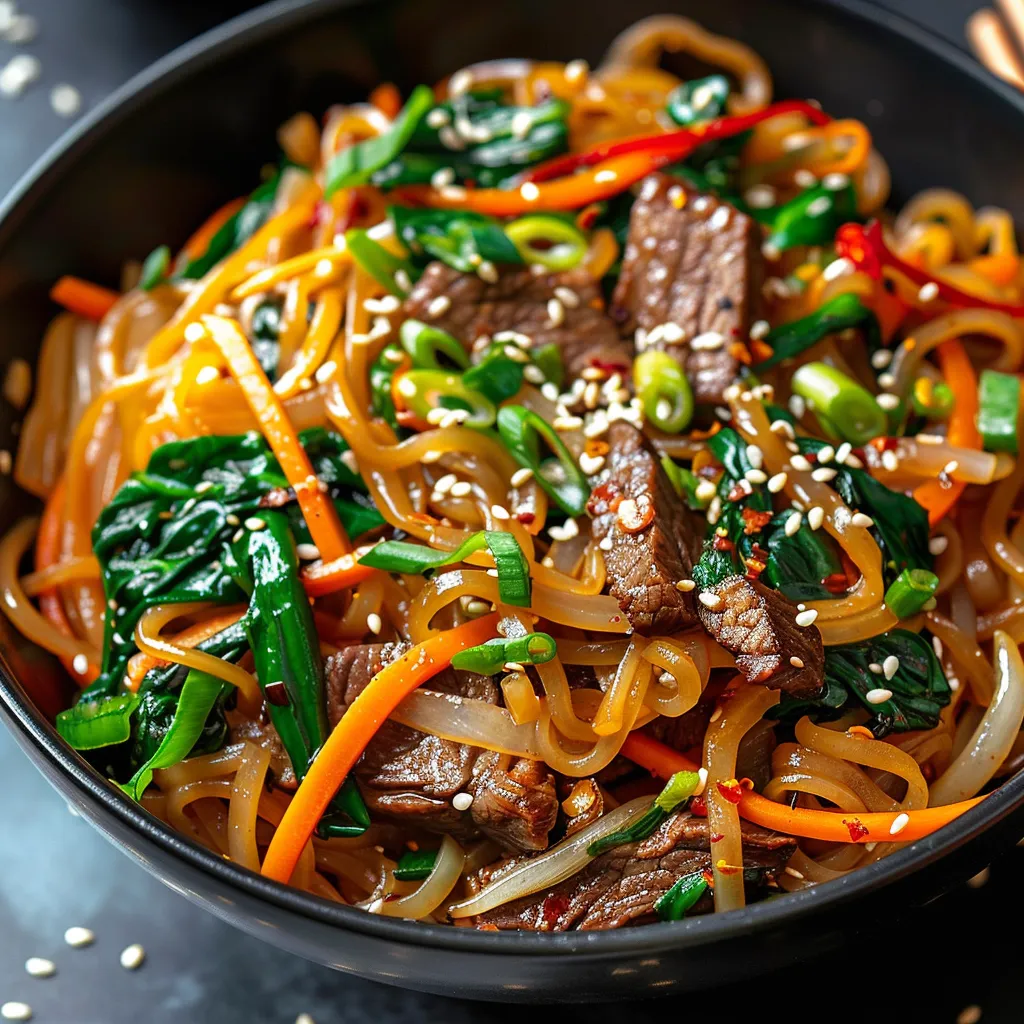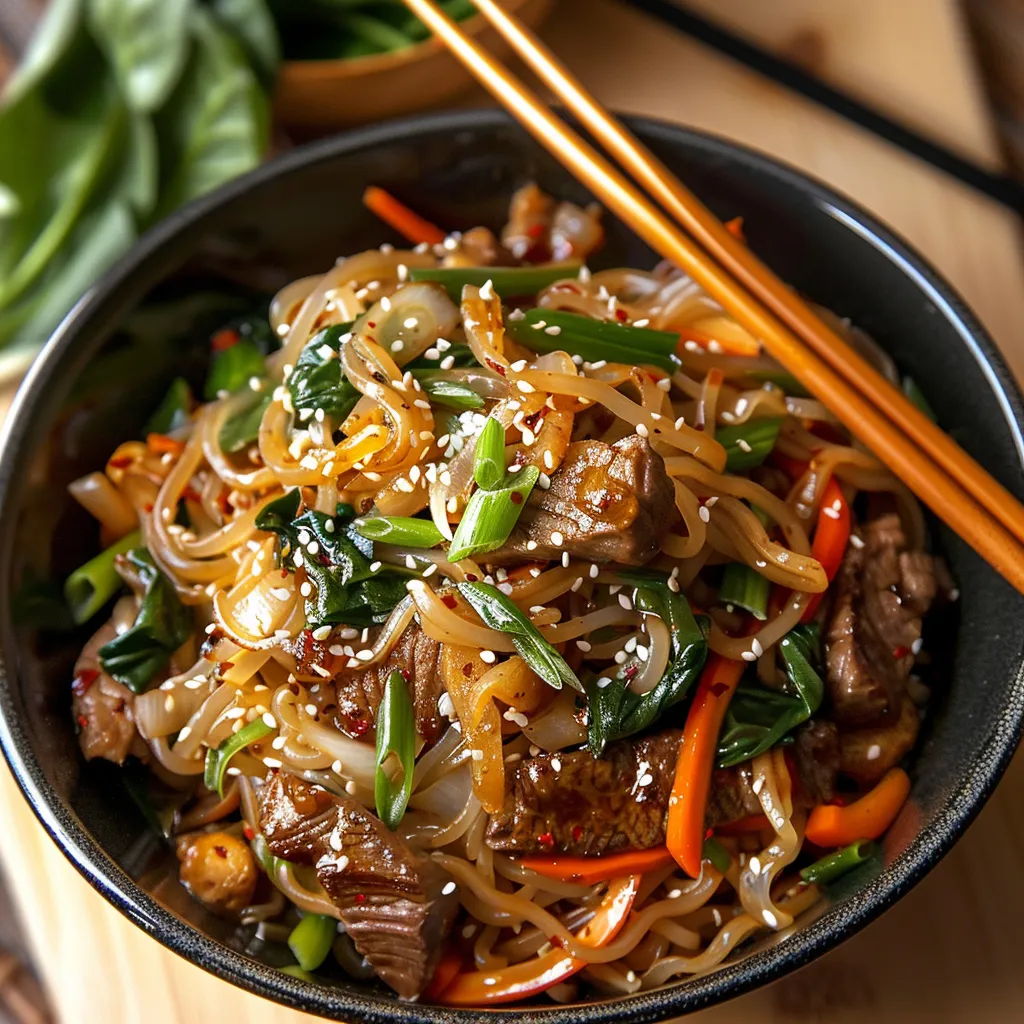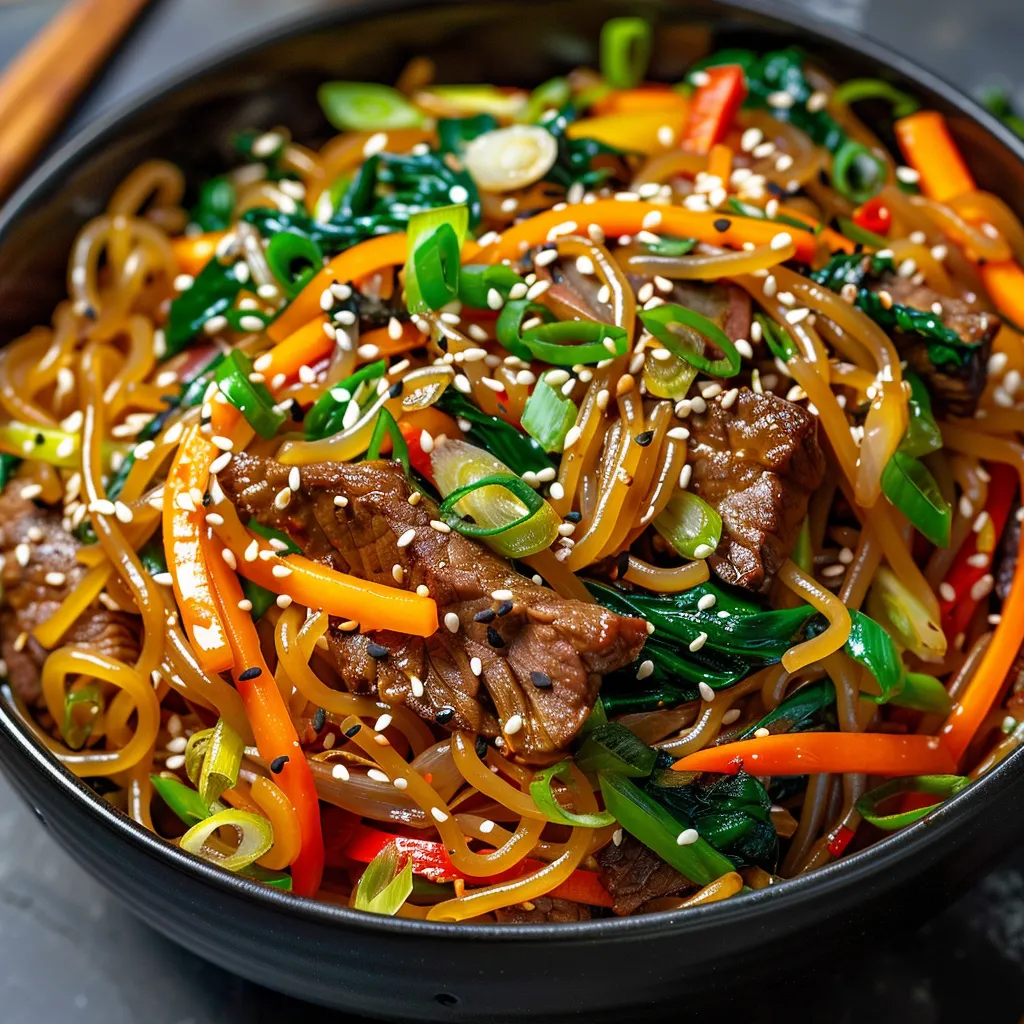 Pin it
Pin it
A celebration of Korean culinary artistry, Japchae transforms humble sweet potato noodles into a vibrant masterpiece of textures and flavors. Each element undergoes careful preparation before coming together in perfect harmony - from the uniquely chewy dangmyeon noodles that glisten with sesame oil to the rainbow of vegetables prepared to maintain their individual textures. Tender marinated beef adds richness and depth, while the careful balance of seasonings creates a dish that's simultaneously savory, slightly sweet, and deeply satisfying. This beloved Korean specialty represents the perfect balance of colors, textures, and flavors that characterizes Korean cuisine's sophisticated approach to balanced eating.
My journey with Japchae began in a traditional Korean kitchen, where I learned that timing and temperature control are just as crucial as ingredient selection. Through countless preparations, I discovered that the magic lies in understanding how each component responds to heat and interacts with the sauce. This knowledge, passed down through generations of Korean cooks, ensures that every plate of Japchae achieves its full potential.
Essential Ingredient Selection
- Sweet potato noodles: Require careful inspection before purchase. Look for grayish white, uniform strands without any discoloration or breakage. These noodles should feel firm and slightly springy when pressed
- Beef short ribs: Must be exceptionally fresh and well marbled. Select pieces with bright red coloring and visible marbling for the best flavor and texture when cooked
- Shiitake mushrooms: Should exhibit firm, unblemished caps with a deep brown color. Fresh specimens will have a distinct earthy aroma and no signs of moisture or softness
- Fresh vegetables: Need careful selection. Carrots should be firm and bright orange, spinach must have crisp, dark green leaves, and bell peppers should feel heavy for their size with glossy skin
- Toasted sesame oil: Demands careful consideration. Choose bottles stored away from light with a rich, nutty aroma. Check production dates to ensure freshness
Creating Perfect Japchae
- Noodle Preparation:
- Begin with properly cooked dangmyeon, testing regularly for that signature chewy texture. The noodles require careful attention during cooking - too short and they remain tough, too long and they become mushy. Start by bringing a large pot of water to a rolling boil, adding the noodles gradually to prevent clumping. Stir occasionally and test every minute after the five minute mark by removing a strand and biting through it. The perfect noodle should be clear but still offer resistance when bitten. Immediately shock in cold water to stop the cooking process and preserve the ideal texture.
- Vegetable Orchestration:
- Cook each vegetable separately to honor its unique characteristics and cooking time. Begin with onions, allowing them to develop golden edges that provide depth of flavor. Mushrooms follow, cooking until they release their moisture and begin to caramelize. Carrots require precise cutting into matchsticks of equal size for even cooking and visual appeal. Spinach needs mere seconds in the pan, just enough to wilt while maintaining its bright green color. This methodical approach ensures each vegetable contributes its optimal flavor and texture to the final dish.
- Protein Perfection:
- Marinate beef slices in a carefully balanced mixture of soy sauce, garlic, and sesame oil. The marinade should coat each piece evenly, with the sugar helping to create caramelization during cooking. Allow at least twenty minutes for flavors to penetrate, but no longer than two hours to prevent the meat from becoming too salty. Cook in small batches over extremely high heat, spreading pieces evenly to prevent overcrowding. Each slice should develop a golden brown exterior while remaining tender inside.
- Final Assembly:
- Layer components thoughtfully in your largest mixing bowl, beginning with the sauce at the bottom. Add noodles next, allowing them to absorb the sauce's flavors. Arrange vegetables by color, creating a visually striking presentation before the final toss. Use two spoons or clean hands to gently lift and fold ingredients together, ensuring even distribution of sauce and preventing the noodles from breaking.
 Pin it
Pin it
Serving Suggestions
Present your Japchae with thoughtful consideration to temperature and accompaniments. The dish shines brightest when served just slightly warm or at room temperature, allowing the full spectrum of flavors to emerge. Arrange it on a large, decorative platter or in individual bowls, garnishing with additional sesame seeds and thinly sliced green onions cut on a precise diagonal. Consider serving alongside traditional Korean accompaniments such as kimchi, whose tangy spiciness provides perfect contrast to the Japchae's subtle sweetness. Small dishes of additional sesame oil and soy sauce allow guests to adjust seasoning to their preference.
Creative Variations
While maintaining respect for traditional preparation, explore different interpretations that honor the dish's essence. Consider substituting the beef with tender strips of pork belly marinated in the same seasonings but with added gochugaru for subtle heat. For a vegetarian version, replace meat with pan seared king oyster mushrooms, sliced lengthwise to mimic the texture of meat. Experiment with seasonal vegetables like tender asparagus in spring or sweet bell peppers in summer, always maintaining the balance of colors and textures that makes Japchae special.
Storage Solutions
Proper storage ensures this dish remains delicious for several days. Allow Japchae to cool completely before transferring to an airtight container, arranging it in layers separated by parchment paper to prevent clumping. Store in the refrigerator for up to three days, bringing it to room temperature before serving. When reheating, do so gently in a pan over medium low heat with a splash of water to restore moisture, or enjoy it cold as a refreshing noodle salad.
 Pin it
Pin it
Frequently Asked Questions
- → What are sweet potato noodles (dangmyeon)?
- These are Korean glass noodles made from sweet potato starch, known for their chewy texture and translucent appearance.
- → Can I make this vegetarian?
- Yes, simply omit the beef and add more mushrooms or tofu for protein.
- → Why cook ingredients separately?
- This preserves the distinct texture and color of each ingredient for better presentation and taste.
- → Where can I find sweet potato noodles?
- Look in Asian grocery stores or the Asian section of large supermarkets.
- → Can I make this ahead?
- Yes, it keeps well for 3 days in the fridge and makes great leftovers.
